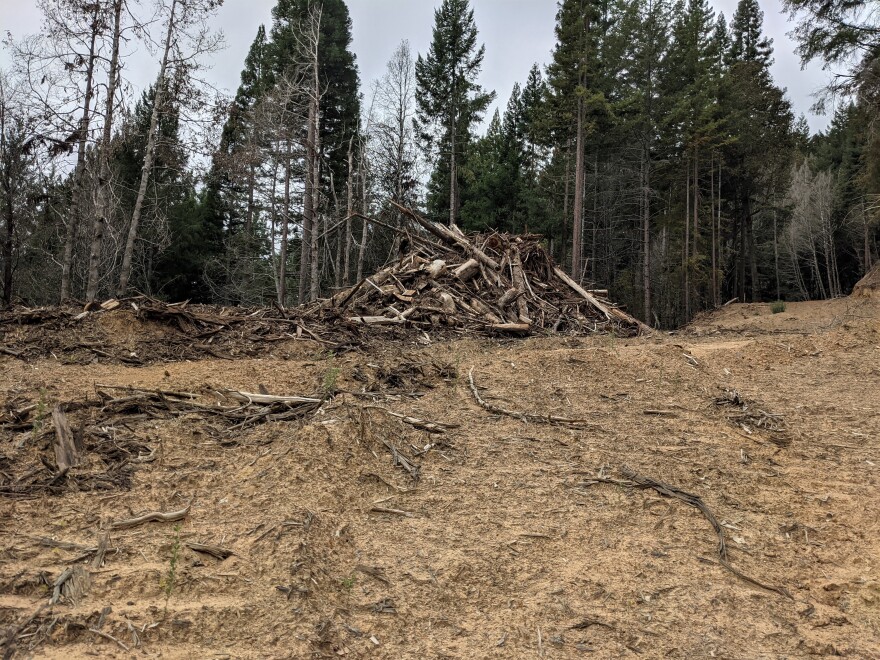November 16, 2021 — The Board of Supervisors voted unanimously on Monday to pass a resolution asking for a scientific review of the management at Jackson Demonstration State Forest, with an eye toward meeting environmental goals laid out by the governor. County supervisors do not have jurisdiction in the forest, which is managed by Cal Fire under the authority of the state. A moratorium on all logging within JDSF, long a demand of activists, was not under consideration.
Priscilla Hunter, former Chair of the Coyote Valley Band of Pomo Indians and current Tribal Historic Preservation Officer, opened public comment, with measured support. “This is a good first step,” she said; “however, there’s a lot of concerns that we have regarding fire, water, and one of our main issues is regarding the restoring of our sacred sites. And if they keep continuing to cut those trees down by those sites, they are continuing to destroy our cultural sites. We can’t even get in there to be able to go up and pray there and see where our ancestors held their ceremonies. It’s very, very hurting.”
Fifteen-year-old Sara Rose, a member of the Coalition to Save JDSF, spoke about the future, saying, “The climate crisis has been a huge part of my childhood. I knew from a very young age that it would be the biggest threat to my future...if we do nothing, the climate crisis will be the end of humanity...JDSF is home to thousands of acres of second-growth coast redwoods. These trees sequester more carbon than any other trees on earth. Cutting them down would release hundreds of thousands of pounds of carbon dioxide into our atmosphere, exacerbating the effects of climate change unbelievably. If cut down, they will not regrow in my lifetime.”
Marie Jones, the chair of the Mendocino County Climate Action Committee, told the Board that a wide coalition of environmental organizations supports the resolution, and added a few requests about the science. “That research should be peer-reviewed, transparent, and credibly managed by an independent third party,” she declared.
Michael Jones, the UC cooperative extension forestry advisor for Mendocino County, called in from where he was conducting research in JDSF on prescribed burns, to say the current management plan is already being used to inform the state’s decisions on climate change. He said JDSF, and Parlin Fork in particular, is the only place where prescribed burns are taking place on a landscape level in the redwood forest.
“For example, I have research ongoing here,” he said. “It’s on climate change, it’s on forest management, it’s on wildfire risk, it’s on prescribed fire, all these really high-priority topics. The narrative, and the way this resolution is framed, and the conversation we’re having, is completely ignoring the fact that, as I’ve stated now, the forest is already moving into the research that is informing the statewide policy directives.”
When Supervisor Ted Williams asked Dr. Jones if there were any findings in the resolution that he found inaccurate, he said, “I actually do. I disagree with some of the language used. I think that the reductionist argument that the forest is managed primarily for commercial applications is a hundred percent incorrect. I don’t think there has been a THP (timber harvest plan) or a management plan that I have reviewed or been involved in that does not have an aspect of forest restoration, forest management, or research built into it.”
But the majority of public comment was supportive of the resolution. William Lemos, co-chair of the Mendocino Trail Stewards, described some of what he’s seen in JDSF, recalling that, “In 2018, just across Road 409 from us, a number of clear cuts took place all the way up to Observatory Hill, and if you want to take a walk and look at those clear cuts, you’ll see slash piles remaining from that 2018 cut. And if you’ve looked at some of the research done by climatologist J.P O’Brien, he sent Google Earth pictures of what’s going on in Parlin Fork, and on that tributary, it looks like dozens of clear cuts are either in the process of happening or have already happened.”
Kevin Conway, the JDSF forest manager for CalFire, assured the Board that the forest is in much better shape than it was when his agency took it over, in the 1940s. “So we’re concerned that adopting this resolution as written today will provide legitimacy to this false narrative,” he cautioned the Supervisors.
And JDSF is the site of significant economic activity for some people. Bruce Burton, one of the co-founders of the Willits Redwood Company, told the Board that without logging in the Caspar 500 timber harvest plan, he’s had to bring in logs from Santa Cruz and Humboldt Counties. “That represented close to 50% of our consumption for the year,” he said, adding that locally-owned Anderson Logging, which his company had contracted to perform the work, “immediately had to find other work for 40 employees they had assigned to that task.”
Supervisor Glenn McGourty said he didn’t want to stifle the timber industry or the science that’s already being done in JDSF, but, “It seems kind of strange, at this late date, that CalFire would be okaying clear cuts. I mean, clear cuts are so out of date for a redwood forest type as a way of management, it just seems really strange that anybody would even contemplate that. If we’re going to grow forests to grow quality timber and also sequester carbon, what we want to move towards is late seral stage forestry or something that mimics it, which is older trees.”
The board voted 5-0 to ask the governor for a scientific review of the forest, but also committed to more meetings with the Jackson Advisory Group and CalFire.
Audio version of "Supervisors vote unanimously to request JDSF review"



